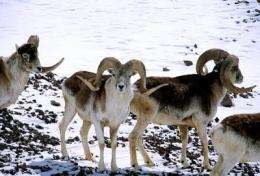World's largest sheep an international traveler

A genetic study of the world's largest sheep species has revealed that the big-horned animals travel extensively across the moutainous borders of Afghanistan, Tajikistan, and China according to Wildlife Conservation Society researchers with the support of the U.S. Agency for International Development (USAID).
Using a non-invasive technique that extracts DNA from fecal samples, researchers in WCS's Afghanistan Program found that Marco Polo sheep in the Pamir Mountains of Afghanistan are genetically connected to sheep in neighboring Tajikistan and China, in spite of the challenging terrain.
The study produced two recently published papers, appearing in recent editions of Conservation Genetics and Journal of Wildlife Management. The authors of the papers include: Richard.B. Harris of the University of Montana, and John Winnie, Jr.of Montana State University (both of whom did their work under the auspices of the Wildlife Conservation Society); Gordon Luikart, Stephen. J. Amish, and F.W. Allendorf of the University of Montana; and Albano Beja-Pereira, Vânia Costa, and Raquel Godinho of the Universidade do Porto (Portugal).
"Wide-ranging species such as Marco Polo sheep are difficult to monitor in the best of conditions, and our ability to follow them across their mountain habitats is limited," said Richard B. Harris, a wildlife scientist from the University of Montana and the Wildlife Conservation Society. "Non-invasive methods of determining population trends and relatedness are extremely valuable in understanding how to best protect these magnificent animals."
Because Marco Polo (or argali) sheep are elusive animals that are difficult to track, the research team collected fecal samples from 172 individual sheep from five different areas in Afghanistan, Tajikistan, and China as a means of answering questions about the genetic diversity and connectivity of animals in the region. Researchers searched for sheep on high vantage points, collecting fecal pellets after a group of animals was located. Genetic material was then extracted from the fecal matter and isolated for statistical analysis.
According to the study results, Marco Polo sheep populations in the Pamirs have a high degree of genetic diversity. Indications of genetic connectivity were detected between sheep populations in both Afghanistan and Tajikistan. Sheep in China, however, were found to be somewhat more isolated, highlighting a need for international collaboration in protecting corridors between the region's countries.
"Genetic studies such as these are the only feasible option for answering important questions on how to best manage wide-ranging species that occur in remote locations such as the Marco Polo sheep," said Peter Zahler, Deputy Director for WCS's Asia Program. "The study's results underline the need for international cooperation between Afghanistan, Tajikistan, China, and even Pakistan to ensure that the world's Marco Polo sheep populations can continue to move across these giant mountains as needed, irrespective of political boundaries."
With the assistance of WCS and support from USAID (United States Agency for International Development), the government of Afghanistan has launched several initiatives to safeguard the country's wild places and the wildlife they contain. In 2009, the government gazetted the country's first national park, Band-e-Amir. The park was established with technical assistance from WCS's Afghanistan Program. WCS also worked with Afghanistan's National Environment Protection Agency (NEPA) in producing the country's first-ever list of protected species, an action that now bans the hunting of snow leopards, wolves, brown bears, and other species. In a related effort, WCS now works to limit illegal wildlife trade in the country through educational workshops for soldiers at Bagram Air Base and other military bases across Afghanistan. WCS also works with more than 55 local communities in Afghanistan to better manage their natural resources, helping them conserve wildlife while improving their livelihoods. WCS has helped train and deploy more than 50 community rangers to monitor wildlife such as Marco Polo sheep, and also patrol the region to stop poaching.
The Marco Polo sheep is actually a subspecies of argali and is named after the 13th Century explorer who described the animal in his travelogue. Argali are classified as Near Threatened by the International Union for the Conservation of Nature (IUCN). Marco Polo sheep are threatened by human-related activities such as poaching, habitat degradation and fragmentation.
Provided by Wildlife Conservation Society


















